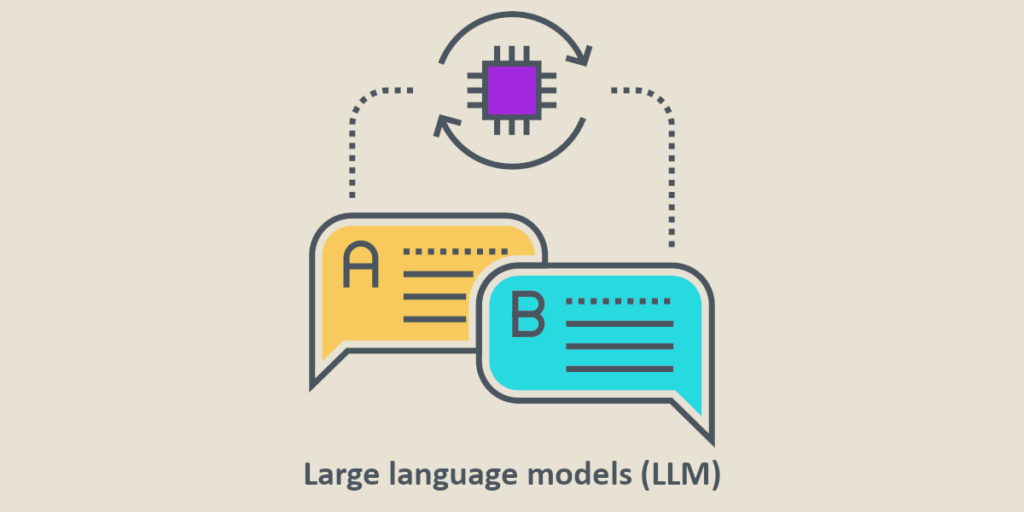Since the end of 2022 and the massive worldwide use of ChatGPT, artificial intelligence-based language models have been attracting increasing interest, both from the general public and from businesses. So what are large language models? How do they work? What are they used for? What are their advantages? Find out in this article.
What are large language models?
Whether it’s to communicate, connect, understand the world, or shape it, language is crucial to our humanity. What characterizes us? Not so much. Despite the complexity of human language, machines are now able to understand its subtleties thanks to large language models (LLMs). By using as much data as possible in their training, these new technologies have developed a richer understanding of language than ever before.
In concrete terms, this is a transform-based neural network. These basic models use generative AI (and more specifically Deep Learning) for natural language processing (NLP) and natural language generation (NLG).
How do large language models work?
As the aim of large language models is to learn the complexity of human language, they are pre-trained on a large amount of data (such as text, images, videos, speech, and structured data…). The more parameters an LLM uses, the better its performance. As such, large linguistic models require significant resources in terms of data, computation, and engineering.
This is particularly true in the pre-training phase. At this stage, large language models need to learn basic linguistic tasks and functions. Once the learning model has been pre-trained, it can be trained with specific new data. The aim is to refine its capabilities for specific use cases. This is known as fine-tuning. This learning phase requires less data and energy.
What are LLMs used for?
Large language models can be used for a multitude of tasks. For example:
- Question and answer ;
- Sentiment analysis
- Information extraction;
- Image capture;
- Object recognition;
- Instruction tracking;
- Text generation ;
- Text summarization ;
- Content creation;
- Chatbots, virtual assistants, and conversational AI (typically the case with open source Chat GPT);
- Translation ;
- Predictive analytics;
- Fraud detection;
- Etc.
Thanks to their multiple functionalities, LLMs are perfectly suited to all sectors of activity (banking, logistics, healthcare, industry, etc.).

What are the advantages of LLMs?
For organizations, large language models are a real boon. And with good reason: they enable :
Automate processes
Language models can be used to automate a wide range of processes, such as customer service, text generation, prediction and classification, and so on.
Freed from these time-consuming tasks, employees can focus on more rewarding activities that require genuine human expertise.
Incorporating strategies for employee rewards and recognition can further boost morale, ensuring that employees feel valued as they take on more meaningful work.
Automation with LLM, therefore, reduces manual work time and associated costs.
Promoting personalization
Thanks to chatbots and virtual assistants using large language models, customer service can be provided 24/7. They can process vast quantities of data to understand customer behavior and preferences. Even if automated content creation is involved, language models are fully capable of personalizing interactions thanks to training carried out upstream.
Between personalization and availability, customer satisfaction increases.
Increase task accuracy
By processing large quantities of data, LLMs improve the accuracy of prediction and classification tasks.
For example, after a satisfaction survey, a large language model can analyze thousands of customer reviews to understand the sentiment behind each one. It can more accurately identify whether a customer review is positive, negative, or neutral.

What are the limits and challenges?
Despite all the benefits offered by LLMs, it’s important to be aware of their limitations. To wit:
Bias: the capabilities of language models are limited to the textual data with which they are trained. This can lead to misinformation, bias, and even toxic language.
The contextual window: each large language model has only a certain amount of memory. Beyond a certain number of input tokens, they will no longer be able to perform the required tasks.
Costs: the development of large language models requires considerable investment (IT systems, human capital, energy, etc.).
Environmental impact: LLM projects use hundreds of servers. These servers consume enormous amounts of energy, creating a considerable carbon footprint.
Key facts:
Large language models are neural networks that use huge volumes of data to understand human language.
The considerable development of these LLMs makes it possible to carry out extremely varied and increasingly complex tasks.
While these large language models are beneficial for business, it is important to be aware of their limitations (impact on the environment, cost, bias, etc.).










